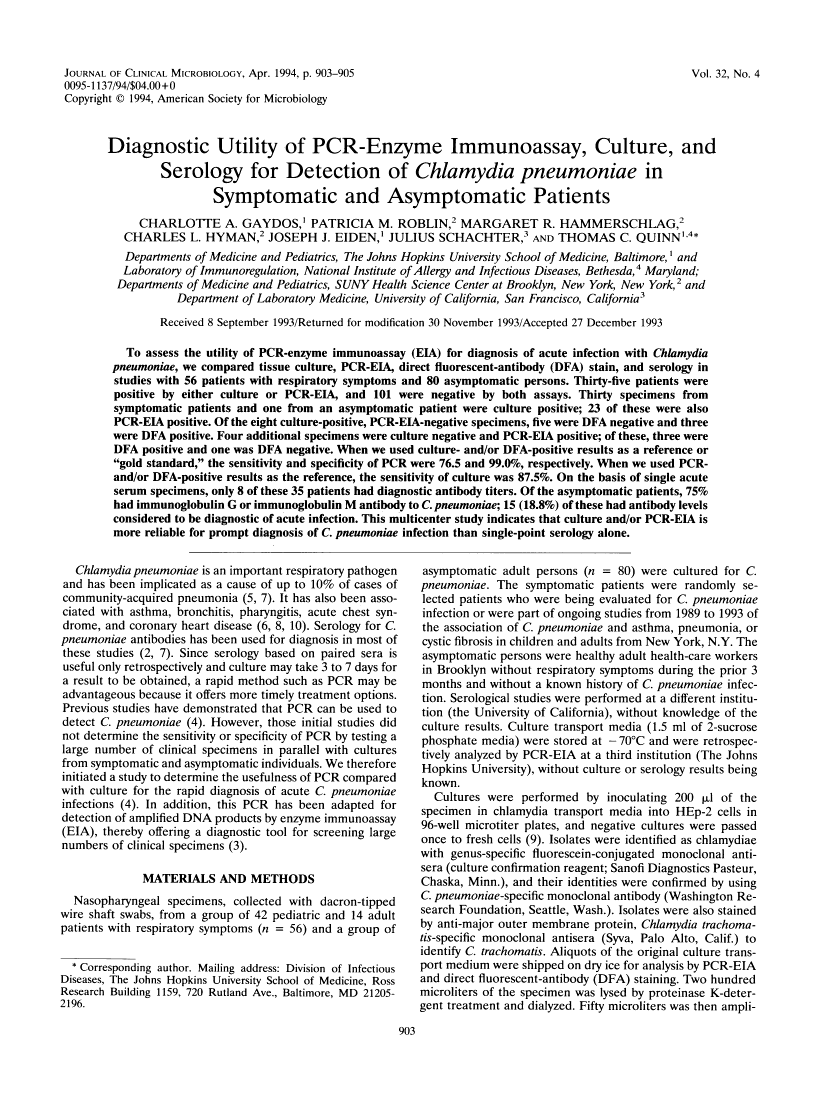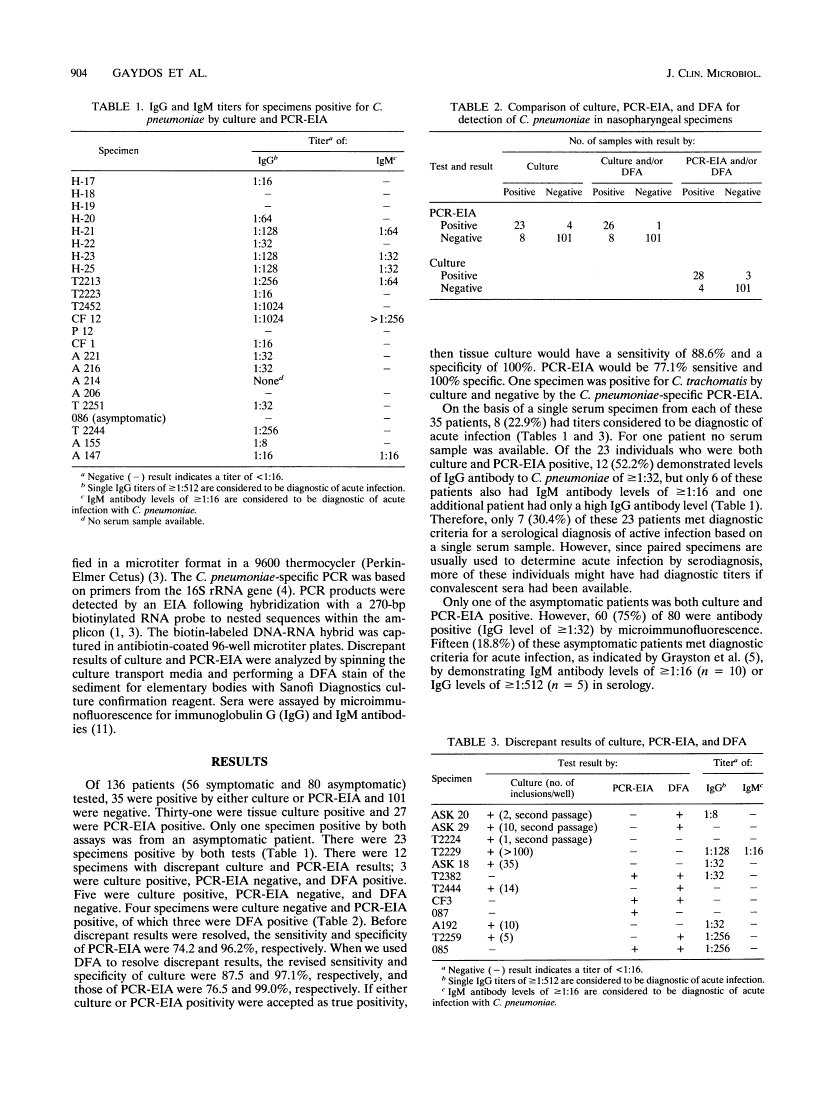Abstract
Free full text

Diagnostic utility of PCR-enzyme immunoassay, culture, and serology for detection of Chlamydia pneumoniae in symptomatic and asymptomatic patients.
Abstract
To assess the utility of PCR-enzyme immunoassay (EIA) for diagnosis of acute infection with Chlamydia pneumoniae, we compared tissue culture, PCR-EIA, direct fluorescent-antibody (DFA) stain, and serology in studies with 56 patients with respiratory symptoms and 80 asymptomatic persons. Thirty-five patients were positive by either culture or PCR-EIA, and 101 were negative by both assays. Thirty specimens from symptomatic patients and one from an asymptomatic patient were culture positive; 23 of these were also PCR-EIA positive. Of the eight culture-positive, PCR-EIA-negative specimens, five were DFA negative and three were DFA positive. Four additional specimens were culture negative and PCR-EIA positive; of these, three were DFA positive and one was DFA negative. When we used culture- and/or DFA-positive results as a reference or "gold standard," the sensitivity and specificity of PCR were 76.5 and 99.0%, respectively. When we used PCR- and/or DFA-positive results as the reference, the sensitivity of culture was 87.5%. On the basis of single acute serum specimens, only 8 of these 35 patients had diagnostic antibody titers. Of the asymptomatic patients, 75% had immunoglobulin G or immunoglobulin M antibody to C. pneumoniae; 15 (18.8%) of these had antibody levels considered to be diagnostic of acute infection. This multicenter study indicates that culture and/or PCR-EIA is more reliable for prompt diagnosis of C. pneumoniae infection than single-point serology alone.
Full text
Full text is available as a scanned copy of the original print version. Get a printable copy (PDF file) of the complete article (598K), or click on a page image below to browse page by page. Links to PubMed are also available for Selected References.
Selected References
These references are in PubMed. This may not be the complete list of references from this article.
- Bobo L, Coutlee F, Yolken RH, Quinn T, Viscidi RP. Diagnosis of Chlamydia trachomatis cervical infection by detection of amplified DNA with an enzyme immunoassay. J Clin Microbiol. 1990 Sep;28(9):1968–1973. [Europe PMC free article] [Abstract] [Google Scholar]
- Fang GD, Fine M, Orloff J, Arisumi D, Yu VL, Kapoor W, Grayston JT, Wang SP, Kohler R, Muder RR, et al. New and emerging etiologies for community-acquired pneumonia with implications for therapy. A prospective multicenter study of 359 cases. Medicine (Baltimore) 1990 Sep;69(5):307–316. [Abstract] [Google Scholar]
- Gaydos CA, Fowler CL, Gill VJ, Eiden JJ, Quinn TC. Detection of Chlamydia pneumoniae by polymerase chain reaction-enzyme immunoassay in an immunocompromised population. Clin Infect Dis. 1993 Oct;17(4):718–723. [Abstract] [Google Scholar]
- Gaydos CA, Quinn TC, Eiden JJ. Identification of Chlamydia pneumoniae by DNA amplification of the 16S rRNA gene. J Clin Microbiol. 1992 Apr;30(4):796–800. [Europe PMC free article] [Abstract] [Google Scholar]
- Grayston JT, Campbell LA, Kuo CC, Mordhorst CH, Saikku P, Thom DH, Wang SP. A new respiratory tract pathogen: Chlamydia pneumoniae strain TWAR. J Infect Dis. 1990 Apr;161(4):618–625. [Abstract] [Google Scholar]
- Hahn DL, Dodge RW, Golubjatnikov R. Association of Chlamydia pneumoniae (strain TWAR) infection with wheezing, asthmatic bronchitis, and adult-onset asthma. JAMA. 1991 Jul 10;266(2):225–230. [Abstract] [Google Scholar]
- Marrie TJ, Grayston JT, Wang SP, Kuo CC. Pneumonia associated with the TWAR strain of Chlamydia. Ann Intern Med. 1987 Apr;106(4):507–511. [Abstract] [Google Scholar]
- Miller ST, Hammerschlag MR, Chirgwin K, Rao SP, Roblin P, Gelling M, Stilerman T, Schachter J, Cassell G. Role of Chlamydia pneumoniae in acute chest syndrome of sickle cell disease. J Pediatr. 1991 Jan;118(1):30–33. [Abstract] [Google Scholar]
- Roblin PM, Dumornay W, Hammerschlag MR. Use of HEp-2 cells for improved isolation and passage of Chlamydia pneumoniae. J Clin Microbiol. 1992 Aug;30(8):1968–1971. [Europe PMC free article] [Abstract] [Google Scholar]
- Saikku P, Leinonen M, Tenkanen L, Linnanmäki E, Ekman MR, Manninen V, Mänttäri M, Frick MH, Huttunen JK. Chronic Chlamydia pneumoniae infection as a risk factor for coronary heart disease in the Helsinki Heart Study. Ann Intern Med. 1992 Feb 15;116(4):273–278. [Abstract] [Google Scholar]
- Wang SP, Kuo CC, Grayston JT. Formalinized Chlamydia trachomatis organisms as antigen in the micro-immunofluorescence test. J Clin Microbiol. 1979 Aug;10(2):259–261. [Europe PMC free article] [Abstract] [Google Scholar]
Associated Data
Articles from Journal of Clinical Microbiology are provided here courtesy of American Society for Microbiology (ASM)
Full text links
Read article at publisher's site: https://doi.org/10.1128/jcm.32.4.903-905.1994
Read article for free, from open access legal sources, via Unpaywall:
https://jcm.asm.org/content/jcm/32/4/903.full.pdf
Free after 4 months at intl-jcm.asm.org
http://intl-jcm.asm.org/cgi/reprint/32/4/903.pdf
Free to read at intl-jcm.asm.org
http://intl-jcm.asm.org/cgi/content/abstract/32/4/903
Citations & impact
Impact metrics
Citations of article over time
Alternative metrics

Discover the attention surrounding your research
https://www.altmetric.com/details/124518145
Smart citations by scite.ai
Explore citation contexts and check if this article has been
supported or disputed.
https://scite.ai/reports/10.1128/jcm.32.4.903-905.1994
Article citations
Mucositis Secondary to Chlamydia pneumoniae Infection: Expanding the Mycoplasma pneumoniae-Induced Rash and Mucositis Concept.
Pediatr Dermatol, 34(4):465-472, 01 Jun 2017
Cited by: 13 articles | PMID: 28568680
Review
Prevalence and characterization of Chlamydia DNA in zoo animals in Japan.
Microbiol Immunol, 59(9):507-515, 01 Sep 2015
Cited by: 10 articles | PMID: 26215334
Respiratory Infections in the U.S. Military: Recent Experience and Control.
Clin Microbiol Rev, 28(3):743-800, 01 Jul 2015
Cited by: 42 articles | PMID: 26085551 | PMCID: PMC4475643
Review Free full text in Europe PMC
High prevalence of Chlamydia pneumoniae infection in an asymptomatic Jordanian population.
J Microbiol Immunol Infect, 47(5):412-417, 07 Jun 2013
Cited by: 5 articles | PMID: 23751768
Chronic Lyme Disease and Co-infections: Differential Diagnosis.
Open Neurol J, 6:158-178, 28 Dec 2012
Cited by: 36 articles | PMID: 23400696 | PMCID: PMC3565243
Go to all (73) article citations
Similar Articles
To arrive at the top five similar articles we use a word-weighted algorithm to compare words from the Title and Abstract of each citation.
Detection of Chlamydia pneumoniae by polymerase chain reaction-enzyme immunoassay in an immunocompromised population.
Clin Infect Dis, 17(4):718-723, 01 Oct 1993
Cited by: 36 articles | PMID: 8268355
Comparison of two serological methods and a polymerase chain reaction-enzyme immunoassay for the diagnosis of acute respiratory infections with Chlamydia pneumoniae in adults.
J Med Microbiol, 47(7):615-621, 01 Jul 1998
Cited by: 17 articles | PMID: 9839566
[Chlamydia pneumoniae infections--diagnostic methods].
Przegl Lek, 59(3):142-146, 01 Jan 2002
Cited by: 0 articles | PMID: 12184026
Review
Chlamydophila pneumoniae diagnostics: importance of methodology in relation to timing of sampling.
Clin Microbiol Infect, 15(1):42-49, 22 Nov 2008
Cited by: 15 articles | PMID: 19046171







